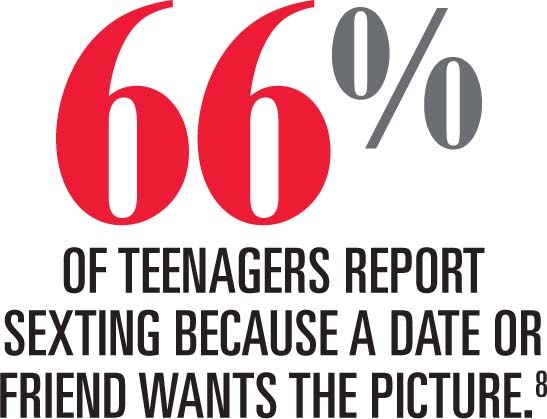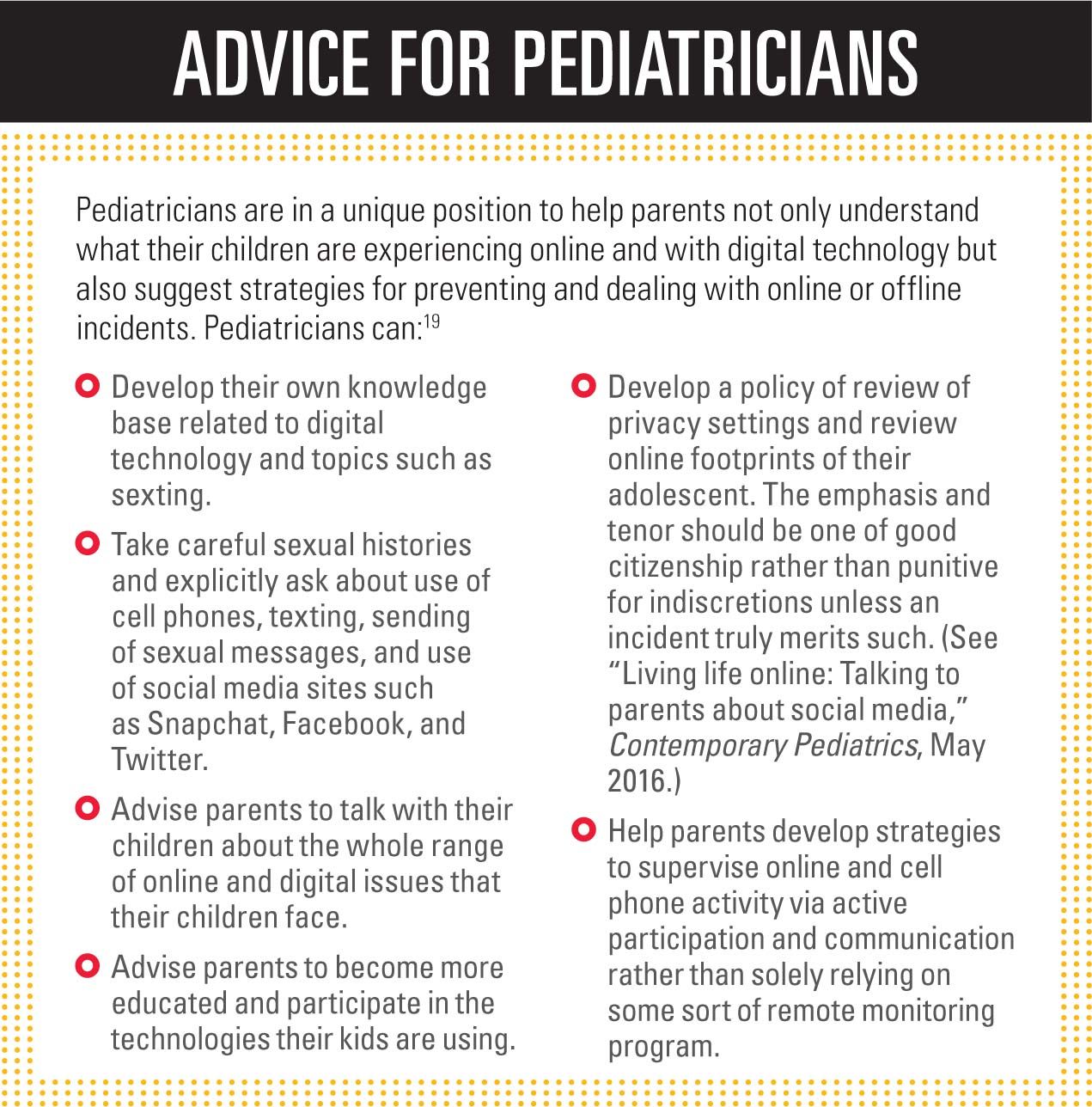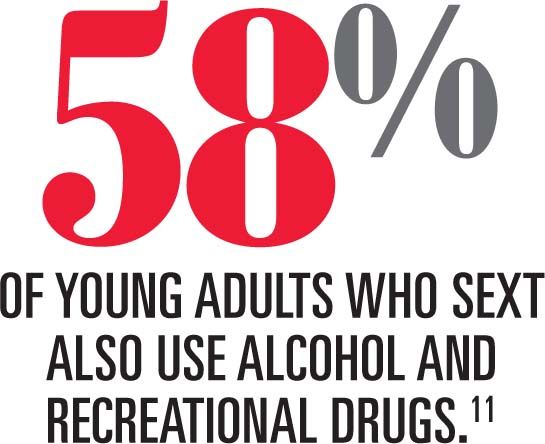Pediatrician’s primer on sexting
Sexting is the act of sending or receiving sexually explicit or sexually suggestive photos, messages, or videos digitally by text, e-mail, or instant messaging from a smartphone or computer device. It is more common among teenagers than one might think.

Sexting is the act of sending or receiving sexually explicit or sexually suggestive photos, messages, or videos digitally by text, e-mail, or instant messaging from a smartphone or computer device. It is more common among teenagers than one might think. Some adolescents do not realize or appreciate the long-term, serious implications sexting may have. Others understand the consequences, but a sense of invulnerability, impulsivity, or sexual desire are stronger motivators.
Some of the consequences of sexting can be severe. The following examples received a great deal of media attention, but unfortunately such instances are not that uncommon:
- In 2008, 2 months after going on a Cincinnati television station to discuss the consequences of sexting gone bad following a relationship breakup so that others might not go through her pain, 18-year-old Jessica Logan committed suicide.1
- In 2012, Amanda Todd was blackmailed by an online predator into showing herself via her webcam. When she refused to continue, the online predator would find her classmates and send them a topless picture Amanda had sent. To deal with her anxiety, Amanda began using drugs, alcohol, and sex. Peers ostracized her. Ultimately, she also committed suicide.2
- In 2015, a Colorado district attorney considered felony criminal charges against high school and middle school students that resulted from hundreds of nude pictures being swapped among students.3
Sexting among adolescents has increased along with access to smartphones. Some teenagers may fail to appreciate the long-term consequences of their actions, although others have sexted with nothing bad happening to them. Pediatricians need to be aware of trends surrounding sexting and develop awareness and counseling skills to help patients and their families as needed.
Sexting is common
Sexting is common among adults with 8 of 10 in respondents to an online poll admitting to sexting (defined as sending or receiving sexually suggestive or explicit content via text) in the prior year. Among adults, 75% sexted as part of a committed relationship whereas more than 40% did so as part of a more casual relationship.4
Recommended: Sexting, dignity, and what we can learn from one another
Among adolescents, it is difficult to determine exactly how many are sexting. In a 2009 Pew Research Center report on teenagers and sexting, 4% of cell-owning teenagers sent sexually suggestive nude images of themselves via text.5 More recent reports estimate prevalence of sexting as between 15% and 28% of adolescents, with the numbers much greater after they enter college.6
Why teenagers sext
There are several reasons why adolescents may engage in sexting. Perhaps for some, it may be a joke or a way to get attention. Teenagers also may see celebrities they admire having lewd pictures and videos exposed, only to have their fame and popularity increase rather than humiliation and ruined reputations that teenagers may experience. For others, sexting is a form of flirtation-seen as cool or a way to become more popular. Finally, peer pressure to sext and the perception that everyone “is doing it” may lead teenagers to report this behavior as normal.
Current literature finds 3 general themes for reasons why teenagers sext:7
· To initiate sexual activity with a boyfriend or a girlfriend;
· As an experimental phase prior to beginning sexual relationships; and
· As a way to enhance current sexual relationships.
In the context of a relationship, the sext is sent as a tool to initiate, keep, or gain attention. Approximately two-thirds of young women often describe the activity as a “sexy” present for a boyfriend, whereas more than half of young men describe sexting as an attempt to “be fun and flirtatious.”7

Pressure or coercion also is a common motivation for teenaged sexting. Girls are significantly more likely to report being pressured, coerced, blackmailed, or threatened into sexting. In 1 report, half of sexts among girls are coerced, which is twice the rate among boys.8 Teenagers seem to be thinking about their relationships when they sext. The most common reasons they report sexting include that a date or boyfriend/girlfriend want the picture (66%) and to attract someone’s interest (65%). Increasing their popularity (22%) and proving that they completely trust a boyfriend or a girlfriend (17%) are less common reasons for sexting. Some experts argue that boys tend to sext from peer pressure of male friends but girls tend to receive pressure from males.7
NEXT: Sexting and other behaviors

In relation to pressured sexts, nearly 70% of requests come from a date, nearly 20% from a friend, and less than 10% result from blackmail or a threat.8
Some studies have demonstrated certain personality traits may be associated with an increased risk of sexting. Adolescents scoring high on assessments of sensation seeking and experiential thinking were more likely to participate in sexting, whereas adolescents scoring higher in rational thinking were less likely to sext.9 Similarly, adolescents displaying higher degrees of impulsivity were also more likely to sext.6
Sexting links to other behaviors
Sexting is associated with a number of other behaviors such as sexual activity and substance use.
Among 1285 students in Los Angeles middle schools participating in the 2012 Youth Risk Behavior Survey, more than two-thirds (68%) owned their own cell phone.10 Of these students, approximately 20% of those with a text-capable cell phone reported receiving a sext and 5% reported sending one. Sending or receiving sexts significantly increased the odds of sexual activity among middle school students (odds ratio [OR], 3.2; 95% confidence interval [CI], 1.3-8.1; and OR, 7.0; 95% CI, 4.0-12.1, respectively). Sending more than 100 texts per day also was associated with both sexting and sexual activity.
Related: Dangers of alcohol and first-time sex for teens
In other studies, sexting is associated with an increased number of sexual partners for both sexual intercourse as well as oral sex.7 One study found that, among young adults, sexting was related to unprotected sex, sex after drinking, and sex after drug use.11 The relationship of high-risk sexual behaviors associated with sexting, however, does not appear to be consistent across studies. Overall, the literature strongly supports that sexting is associated with sexual behavior compared with those who have not sexted, including a study that found sexting predicted sexual behavior.7,10-14
NEXT: Legal Implications

Similarly, sexting appears to be associated with substance use. In a study of 763 young adults, sexting was associated with a significantly increased use of recreational drugs such as alcohol (58.1% vs 42.2%), marijuana (39.5% vs 24.8%), ecstasy (6.8% vs 3.3%), and cocaine (4.7% vs 2.1%) compared with those who did not sext.11 Further, another study of adolescents including 937 ethnically diverse boys and girls found that sexting was associated with both substance use and impulsivity, but was not a marker of mental health.6
Although not often discussed regularly in the research related to sexting, the spread of images without consent and the social exclusion, shame, or insult that are suffered when a teenager no longer has control of the images is a form of cyberbullying. The literature is replete with the negative consequences of this form of abuse.
Legal implications
Although many states have passed laws that significantly lessen penalties for sexting, other states prosecute the sending of a nude picture of a minor under child pornography laws. As a result, a couple of 17-year-olds can legally consent to have sex with each other, but sharing a nude photograph can be prosecuted as child pornography even if the picture is voluntarily shared between 2 people. Any sort of sext between 2 minors is basically a crime.15 Prosecution is rare, but sexting by minors has led to both criminal and civil cases and subsequent legislative action in many states.16
A 2012 article in Pediatrics identified 3477 cases of “youth-produced sexual images,” with approximately 2291 different law enforcement agencies seeing at least 1 case during 2008 and 2009. The study depicts a large heterogeneity of cases that are potentially difficult to prosecute under a single simple law.16
In this sample, 67% were considered aggravated and 33% experimental.16 Aggravated incidents are considered criminal or abusive over and above the creation, possession, or sending of images. The aggravated group was further classified as having adult involvement in cases in which adults solicited or were the recipient of a solicited image versus youth only. Youth-only aggravated incidents involved some sort of intent to harm such as maliciousness, sexual abuse, extortion, or reckless distribution without the knowledge or against the will of the person in the image.
More: How to open up the talk on emergency contraception
An incident was considered experimental when adults were not involved, recklessness was not demonstrated, and there did not appear an intent to harm.16 Experimental was further subdivided into romantic incidents between boyfriend/girlfriend; attention-seeking incidents in the process of attempting to generate a romantic interest or other general attention seeking; and another category that was not readily classifiable.
Of all cases, 36% involved adults.16 Although this included sexual abuse and exploitation cases, 10% of this number were 18- or 19-year-old high school students who likely should have been classified as part of the adolescent peer group, and 5% of adult-involved cases were minors soliciting sex from adults.
Of “youth-only” aggravated cases, 31% demonstrated malicious, nonconsensual, or criminal behaviors.16 Most cases in this category (57%) resulted from lack of consent in sending images. However, 19% involved criminal behavior such as blackmail or abuse in addition to the creation, possession, or sending of images.
NEXT: Advice for parents
Of cases that came to the attention of law enforcement, 33% were considered “experimental” without aggravating factors (32% romantic; 57% attention seeking; 11% other).16
Arrests occurred in 62% of cases where adults were involved, 36% of youth-only aggravated cases, and 18% of experimental cases.16 In the youth-only aggravated cases, 5% of those arrested were subject to sex offender registration. This study demonstrates the behaviors from sexting display a spectrum, from criminal activity, to malicious behavior among adolescents, to what can be considered experimental relationship development, and sexual attention-seeking behaviors among adolescents with no malicious intent.

This report clearly refutes that sexting is a harmless activity to be thought of as a normal part of adolescence.16 Sexting can be seen as a risky behavior even if it does not become a police matter.
Two-thirds of cases identified in this study met federal definitions of child pornography, but comparatively few cases were prosecuted as such.17 Some cases result in having to register as a sex offender when an individual is not much older than the person whose picture they have or transmit. Importantly, two-thirds of all images were confined to a device and not available over the Internet where further exploitation could occur. The heterogeneity of enforcement indicates that law enforcement has not developed a clear consensus on how to handle these cases. It is possible that the 18% of experimental cases prosecuted might have been better handled informally with the family and clinician rather than through the legal system.16
Recommended: CDC STD treatment guidelines
Since 2009, many state legislatures have passed laws specific to sexting. States have created statutes that specify sexting as a misdemeanor, escalate penalties with multiple offenses, create educational diversion programs, or institute civil fines as punishment.17

NEXT: Conclusion
Florida, for example, now has an escalating penalty based on the number of offenses.18 For a first offense, the Florida law allows for issuance of a citation and a combination of penalties including: 8 hours of community service, a $60 civil penalty, and participation in a cyber safety program. Failure to comply can result in loss of one’s driver’s license. A second offense is prosecutable as a misdemeanor and a third as a felony. Laws such as these have taken sexting away from child pornography prosecutions and given district attorneys leeway.15
Next: How to fill gaps in sex education
The pediatrician needs to develop awareness and skills that help identify and bridge the gap between adolescents and adults. Identifying adolescent experimentation versus dangerous behaviors can be difficult for the pediatrician. Failure to understand the dangerous implications of sexting and its place in adolescent sexual behavior can be detrimental for patients, families, and pediatricians.
REFERENCES
1. Celizic M. Her teen committed suicide over ‘sexting.’ Today website. Available at: http://www.today.com/parents/her-teen-committed-suicide-over-sexting-2D80555048. Published March 6, 2009. Accessed July 15, 2016.
2. Common Sense Education. Sexting Handbook. Available at:
https://www.commonsensemedia.org/sites/default/files/uploads/landing_pages/sexting_handbook_ce_1020_1_.pdf. Published 2015. Accessed July 15, 2016.
3. Botelho G, Martinez M. DA: No charges against Colorado students in sexting scandal. CNN website. Available at: http://www.cnn.com/2015/12/09/us/colorado-sexting-scandal-canon-city/. Published December 9, 2015. Accessed July 15, 2016.
4. American Psychological Association. How common is sexting? Available at: http://www.apa.org/news/press/releases/2015/08/common-sexting.aspx. Published August 8, 2015. Accessed July 15, 2016.
5. Lenhart A. Teens and sexting. Pew Research Center web site. Available at: http://www.pewinternet.org/2009/12/15/teens-and-sexting/. Published December 15, 2009. Accessed July 15, 2016.
6. Temple JR, Le VD, van den Berg P, Ling Y, Paul JA, Temple BW. Brief report: teen sexting and psychosocial health. J Adolesc. 2014;37(1):33-36.
7. Henderson L. Sexting and sexual relationships among teens and young adults. McNair Scholars Res J. 2011;7(1):31-39.
8. Englander E. Low risk associated with most teenage sexting: a study of 617 18-year-olds. In: MARC Research Reports. Paper 6. Bridgewater, MA: Massachusetts MARC Aggression Reduction Center, Bridgewater State University; 2012.
9. Van Ouytsel J, Van Gool E, Ponnet K, Walrave M. Brief report: the association between adolescents' characteristics and engagement in sexting. J Adolesc. 2014;37(8):1387-1391.
10. Rice E, Gibbs J, Winetrobe H, et al. Sexting and sexual behavior among middle school students. Pediatrics. 2014;134(1):e21-e28.
11. Benotsch EG, Snipes DJ, Martin AM, Bull SS. Sexting, substance use, and sexual risk behavior in young adults. J Adolesc Health. 2013;52(3):307-313.
12. Gordon-Messer D, Bauermeister JA, Grodzinski A, Zimmerman M. Sexting among young adults. J Adolesc Health. 2013;52(3):301-306.
13. Rice E, Rhoades H, Winetrobe H, et al. Sexually explicit cell phone messaging associated with sexual risk among adolescents. Pediatrics. 2012;130(4):667-673.
14. Dake JA, Price JH, Maziarz L, Ward B. Prevalence and correlates of sexting behavior in adolescents. Am J Sex Educ. 2012;7(1):1-15.
15. Rosin H. Why kids sext. The Atlantic website. Available at: http://www.theatlantic.com/magazine/archive/2014/11/why-kids-sext/380798/. Published November 2014. Accessed July 15, 2016.
16. Wolak J, Finkelhor D, Mitchell KJ. How often are teens arrested for sexting? Data from a national sample of police cases. Pediatrics. 2012;129(1):4-12.
17. Lorang MR, McNiel DE, Binder RL. Minors and sexting: legal implications. J Am Acad Psychiatry Law. 2016;44(1):73-81.
18. 2016 Florida Statutes. 847.0141 Sexting; prohibited acts; penalties. Available at: http://www.leg.state.fl.us/statutes/index.cfm?App_mode=Display_Statute&URL=0800-0899/0847/Sections/0847.0141.html. Accessed July 15, 2016.
19. O'Keeffe GS, Clarke-Pearson K; Council on Communications and Media. The impact of social media on children, adolescents, and families. Pediatrics. 2011;127(4):800-804.
20. Knorr C. Talking about sexting. Common Sense Media website. Available at: https://www.commonsensemedia.org/blog/talking-about-sexting. Published February 5, 2016. Accessed July 15, 2016.
21. Common Sense Media. How do I talk to my teens about sexting? Available at: https://www.commonsensemedia.org/sex-in-the-media/how-do-i-talk-to-my-teens-about-sexting. Accessed July 15, 2016.
Dr Bass is chief medical information officer and associate professor of medicine and of pediatrics, Louisiana State University Health Sciences Center–Shreveport. The author has nothing to disclose in regard to affiliations with or financial interests in any organizations that may have an interest in any part of this article.